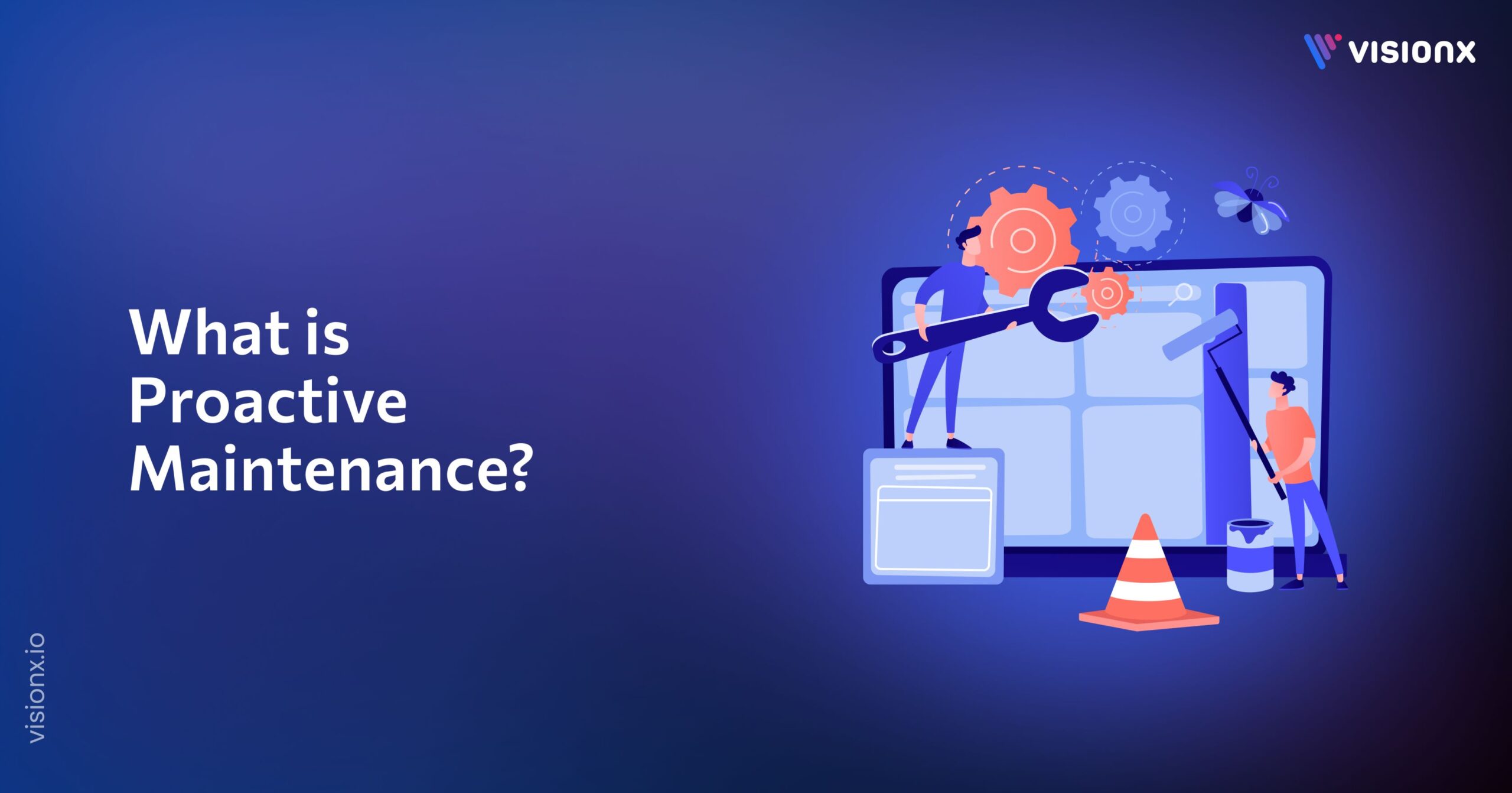We all know the frustration when a critical machine fails. Work comes to a stop, cost increases, and stress and worry levels skyrocket. This unplanned downtime is a significant drain, to the point that a few reports state it costs a company over $260,000 hourly. For a long time, we accepted this cycle of break and fix as a cost of business.
However, there is a more effective way to work, which shifts your team and practices from a position of reaction to one of prevention. This is called proactive maintenance, which seeks to prevent failure of equipment before it even occurs.
In this post, we will walk through the main types of proactive maintenance and then give you a simple roadmap for how you can implement this practice to protect your assets and keep your teams working well.
What is Proactive Maintenance?
Proactive maintenance is a maintenance strategy that focuses on preventing equipment failures before they occur. It relies on scheduled maintenance, performance tracking, and an early fault detection system to maintain machines in top condition. Effectively addressing minor issues before they escalate will limit unplanned downtime, reduce maintenance costs, prolong equipment life, and maximize operational efficiency.
Interestingly, according to McKinsey research, 99% business leader have modified their maintenance strategies over the last few years, with more than 80% of them having switched to either predictive or proactive maintenance of critical assets. This is a significant change in favor of data reliability in the industries.
The key focus of proactive maintenance is to determine the root cause of the problem and remediate it. This is in contrast to the typical maintenance strategies utilized by most teams.
Consider a simple comparison;
- A reactive approach means you fix a machine only after it breaks.
- A preventive plan has you service it on a strict calendar schedule.
- But a proactive maintenance strategy is more nuanced. It uses tools and historical data to monitor a piece of equipment’s health.
You perform maintenance only when the data shows a need. The purpose of this technique is to prolong the lifespan of the machine in the long run.
For example, in an office, the server that stores all the company data is a valuable asset. A reactive team would restore it after a crash. A preventive team might reboot it every Sunday night. A proactive team would use a CMMS to monitor server temperature and drive health. They would see a drive is about to fail and replace it during a quiet period, with no disruption. This is a key proactive maintenance activity that protects the business.
How Proactive Maintenance Works: The P-F Curve and Core Principles
If you want to understand proactive maintenance, you have to understand the P-F curve. This model shows why timing is important in a successful maintenance strategy.
The P-F Curve
The P-F Curve maps how equipment fails over time.
- P (Potential Failure): This is the first detectable sign of a problem. Therefore, you may notice a strange noise, an unusual vibration, or an elevated operating temperature.
- F (Functional Failure): This is the point where the equipment completely fails to function. In other words, the machine breaks down entirely.
- The Proactive Window: Meanwhile, this is the critical period between P and F. The goal of proactive maintenance is to detect issues in this window. Repairs done here are simple, cheap, and cause little disruption.
If you wait until the “F” point, you will face a crisis. The repair is complex, expensive, and causes major unplanned downtime.
Proactive Maintenance Workflow
A proactive maintenance workflow follows a clear, data-driven path.
Data Collection and Monitoring
To begin with, the workflow starts with constant data collection. Sensors on critical assets like transformers and switches track performance metrics. As a result, this real-time information forms the foundation for all subsequent analysis.
Analysis and Alert Generation
The sensor data feeds into a central analytics platform. Machine learning processes this information to identify subtle patterns and early warning signs. The system automatically generates alerts when a potential failure is predicted.
Work Order and Dispatch
These alerts then trigger actionable steps. Next, the platform creates a detailed work order and dispatches it directly to the appropriate field crew. In this way, the right team is assigned to the right issue, ensuring efficient and accurate resolution.
Scheduled Repair and Verification
Crews complete the repair during planned hours, preventing unexpected outages. After the work is done, the system continues to monitor the asset to verify the repair’s effectiveness and track performance.
Types of Proactive Maintenance
A modern utility can implement several specific types of proactive maintenance. These distinct approaches form a comprehensive defense against equipment failure.
1. Preventive Maintenance (PM)
Preventive Maintenance consists of periodic, scheduled maintenance for an asset. The maintenance is carried out at predetermined intervals, which are either time or usage-based.
An instance is an oil change of a vehicle after every 5,000 miles, which is an elemental part of the maintenance strategy that eliminates wear and tear from leading to a major failure. It is a basic requirement of the proactive maintenance strategy.
2. Predictive Maintenance (PdM)
Predictive Maintenance is a data-driven technique to predict the failure time. It uses a combination of condition monitoring tools and historical data to make a forecast of the equipment’s future state.
The primary target of predictive maintenance is to organize repair at the very moment the predicted failure point is reached. The method helps in cutting down on unplanned interruptions and in avoiding the early replacement of parts.
3. Condition-Based Maintenance (CBM)
Condition-Based Maintenance is a specific type of predictive maintenance. It dictates that maintenance should only be performed when certain indicators show signs of decreasing performance.
Condition-based maintenance (CBM) uses real-time data from sensors to monitor asset health. Maintenance is then triggered by actual equipment condition, not a preset schedule.
4. Root Cause Analysis (RCA)
Root Cause Analysis (RCA) is a formal method that helps to find out where a problem originates. In case a failure occurs, RCA not only focuses on the very first signs of trouble but also goes deeper to locate the basic cause of it.
The RCA process is foundational to the approach of proactive maintenance because it aims to eliminate the cause, not just address the symptoms, to prevent the same failure from happening again.
5. Scheduled or Periodic Maintenance
This is the practice of performing maintenance on equipment at regular, predetermined intervals. It is similar to Preventive Maintenance but often follows a stricter calendar. This type of maintenance is scheduled beforehand and entered into a computerized maintenance management system (CMMS). It makes sure that the entire critical assets will get the same treatment, which is very important for long-term dependability.
How Proactive Maintenance Differs from Other Strategies
It is easy to mix up maintenance terms. The key difference lies in the goal. Reactive and preventive methods respond to or schedule around failure. Predictive and proactive maintenance aim to get ahead of it, but in different ways.
| Strategy | Main Goal | When Work is Done | Data Used | Outcome |
| Reactive | Fix what is broken | After the equipment fails | None | High downtime, high repair costs |
| Preventive | Prevent failure with scheduled care | On a fixed time schedule | Time passed or meter readings | Less downtime, but some wasted parts and labor |
| Predictive | Predict when a failure will occur | Just before a predicted failure | Real-time sensor data and analysis | Less wasted parts, but it does not address the root causes |
| Proactive | Eliminate the root cause of failure | When root cause analysis shows a need | Machine history and root cause data | Longest asset life, lowest long-term cost |
Benefits of Proactive Maintenance
Proactive maintenance can turn maintenance from a simple cost into a strategic investment. This will provide specific, tangible benefits throughout your operation.
- It drastically cuts unplanned downtime. Machine failures stop production. A strong proactive maintenance program prevents these surprise halts. This keeps your workflow smooth and your team productive.
- It extends the life of your assets. This maintenance approach focuses on root causes. By fixing the source of wear, your equipment lasts longer. This defers major capital expenses for the long run.
- It lowers your total maintenance costs. While there are some upfront costs involved, you will save money long-term. You will be spared from costly emergency repairs and will have to replace parts much less frequently.
- It creates a safer work environment. Catching small issues early stops them from becoming big hazards. This protects your team and your critical assets.
- It gives maintenance managers more control. Your team moves from constant firefighting to planned, valuable work. This makes your operations more reliable and predictable.
Examples of Proactive Maintenance
The following are examples of proactive maintenance that show how different teams use this maintenance strategy to prevent failures.
Manufacturing Plant – Vibration Analysis
A factory tracked motor vibrations on its assembly line. The data showed a small increase in a critical motor’s vibration levels. This early sign pointed to a minor misalignment. The team adjusted the motor during a planned break. This simple fix cost little and prevented a motor seizure that would have stopped the line for hours.
Data Center – Thermal Monitoring
An IT team used thermal sensors to monitor server rack temperatures. They noticed one rack ran hotter than the others. The investigation found a blocked air filter. They cleaned the filter and adjusted the cooling flow. This action prevented server overload and a potential system crash that could have caused major data loss.
Fleet Operations – Oil Analysis
A truck company analyzed engine oil samples from its vehicles. The test results for one truck showed high metal content. This indicated early engine wear. On a planned maintenance day, the team fixed the engine. This prevented a disastrous engine failure while driving, which would have forced a pricey tow and immediate repair.
Proactive maintenance like this reflects how AI in oil and gas industry uses data to detect issues early and prevent costly failures
Common Challenges and How to Overcome Them
The following are the most common issues, along with a few easy ways to remove them.
A. Initial Investment Costs
New sensors, monitoring tools, and software, such as the CMMS, all require upfront investment. This upfront cost can be tough for customers to approve.
Solution: Start small with your customer. Pick one important production line or a few key assets to run your pilot initiative. Use the results and cost savings from this small initiative to promote and get approval for a larger deployment. Use the terminology of a long-term investment or business case for a spending proposal, not a cost.
B. Resistance to Cultural Change
Teams that are used to proactive incident control might not trust a new system. They might regard planned inspections as an imposition.
Solution: Get your technicians involved at the start. Demonstrate to them how the proactive maintenance solutions will not only make their jobs easier but also safer by avoiding emergencies. Provide training and celebrate small victories in order to win over the trust in the newly instituted process.
C. Data Overload and Analysis Paralysis
Condition monitoring produces an enormous amount of data. Without a well-defined plan, the teams will feel inundated and unable to act.
Solution: Identify the metrics that matter most. Start by monitoring a limited set of indicators from your most valuable assets. Use your CMMS to establish threshold alerts, allowing the system to identify only the data that is valuable and that needs a human’s attention.
Step by Step: How to Implement a Proactive Maintenance Program
Follow these five steps to build and implement your proactive maintenance strategies. This approach will help you to stay strong and grow your proactive maintenance strategies over time.
Step 1: Build Your Business Case
Show the clear need for a new maintenance strategy. Utilize your past data to estimate the current expenses due to machine downtime. Make a presentation of this scenario to the management in order to get their backing and also acquire the necessary resources for your preventive maintenance plan.
Step 2: Choose Your Pilot Project
Select one critical asset or production line for your first test. Ideally, focus on equipment where early success will be most visible. This limited scope lets your team learn the new proactive maintenance workflow without overwhelm.
Step 3: Install Monitoring Tools
Install condition monitoring on your experimental setup. Link the detectors for monitoring vibration, temperature, or other essential parameters. At the same time, use your computerized maintenance management system (CMMS) to gather and archive this real-time information.
Step 4: Train Your Team and Refine Processes
Next, teach technicians to use the new tools and interpret the data. Create clear procedures for each proactive maintenance activity. Use this phase to work out any issues with your systems and methods.
Step 5: Review Results and Plan Expansion
Finally, analyze your pilot program results after a set period. Compare the new data with your original baseline. Use these proven results to justify the expansion of your proactive maintenance strategy to other assets.
The method highlighted above serves to establish a clear route for the entire process of installing preventive maintenance solutions. Each stage is based on the previous one and thus allowing a strong base to be created for the success to last long.
How VisionX Uses AI to Strengthen Proactive Maintenance
At VisionX, we assist organizations in reaching AI-induced proactive maintenance by spotting problems beforehand that would lead to downtime. Through state-of-the-art analytics and smart monitoring, we support the maintenance crew in the early identification of risks and the quick taking of measures to avert failures.
This is how we reinforce proactive maintenance:
- Computer Vision: We employ camera-based monitoring to instantly recognize visual anomalies such as leaks, misalignment, or surface wear.
- Data Science: Our specialists decipher huge amounts of equipment data to recognize patterns, foresee breakdowns, and enhance performance.
- Custom AI Models: We create personalized AI systems that are tailored and constructed according to each organization’s particular assets and working circumstances.
The integration of these AI capabilities allows us to aid the maintenance team in cutting down unplanned downtime, increasing asset life, and moving from reactive repairs to genuinely predictive operations.
Are you set to make your maintenance strategy more intelligent? Get in touch with us to achieve the entire potential of AI-driven proactive maintenance.
FAQs
What is proactive maintenance vs. preventive maintenance?
Preventive maintenance is done on a regular basis. Proactive maintenance is a type of maintenance where real-time information is used to decide when to service the vehicle. This data-driven method usually provides an alert on matters that a calendar-based schedule would have failed to notice.
What is the difference between preventive and reactive maintenance?
Reactive maintenance is the repair of equipment once it has failed. Preventive maintenance is a strategy to avoid such failures through routine, scheduled maintenance. Planned action and emergency response are the most significant distinctions.
Which industries benefit most from proactive maintenance?
Any industry with critical, expensive equipment benefits greatly. This includes manufacturing, energy production, and aviation. The utility industry is a prime candidate due to its widespread infrastructure and the high cost of failures.
How can AI improve proactive maintenance?
AI can analyze complex sensor data to find subtle patterns humans miss. It provides more accurate failure predictions. This allows maintenance teams to intervene at the most effective moment.


